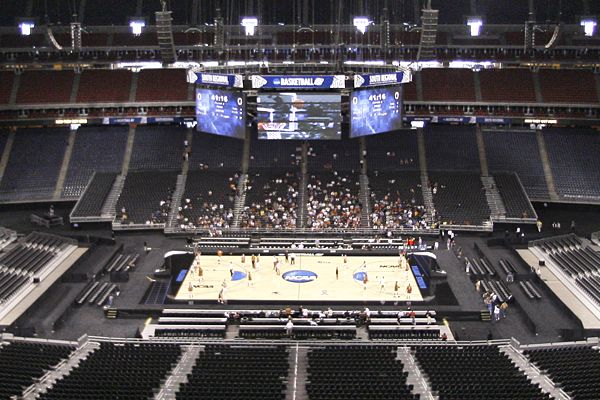Hosting Final Fours in Large Football Domes Makes the Most Sense
Posted by Chris Johnson on September 11th, 2012Chris Johnson is an RTC columnist. He can be reached @ChrisDJohnsonn.
It always seemed slightly awkward that the Final Four, college basketball’s marquee postseason event, is played out in 70,000-seat football arenas across the country, rather than buildings actually designed to house basketball events. Fans spend the season watching their teams compete in basketball arenas across the country, many of which offer unique, quaint environments that are as much a part of the program as the team itself. In world where ticket revenue maximization and logistical considerations are the driving forces behind stadium construction and renovation, it’s these college hoops atmospheres – Hinkle Fieldhouse, Cameron Indoor Stadium, the Palestra – that give the sport a certain level of authenticity. There’s something endearing about the program-specific uniqueness that envelops college arenas, something vaguely intangible the sport simply wouldn’t be the same without. It would only make sense to have college basketball’s national champion determined under the same setting – not only for familiarity reasons, but to preserve college basketball’s amateur feel at the highest levels of competition. At the very least, basketball arenas – if not college structures, then NBA stadiums – offer settings far more tolerable than the large and unseemly football dome monoliths that have been adopted for college basketball’s three most important games (two national semifinals, and the championship game).

Large Domes like Ford Field have exclusively hosted the Final Four since 1997. That’s likely to continue for the foreseeable future (Photo credit: David J. Phillip/AP Photo).
But its no secret why the NCAA has opted for these awkward hosting sites. For one, bigger stadiums means more seats, which means more ticket revenues. If fans are willing to fill a reasonable proportion of a football dome’s enormous seating capacity in spite of several unattractive features – poor viewing angles, increased ticket prices – then it’s hard to argue with keeping the games in these large structures. From a revenue perspective, it just makes sense. But there are a host of other concerns to consider: space for increasing media contingents, infrastructural necessities (restaurants, hotels, parking, etc.), the conventions and parties and fan events that accompany major sporting events like the Final Four. Large football domes, despite all their aesthetic shortcomings, are better-equipped to handle the event in this regard. In short, football arenas in large cities offer the optimal blend of seating accommodations and resourceful necessities for hosting a sporting spectacle as massive and as important as the Final Four.
The NCAA’s discussion of a move to basketball arenas in major metropolitan cities, according to ESPN.Com’s Andy Katz, would eliminate the primary benefit for both attending fans and the NCAA: enormous seating capacities, the likes of which incentivized the move away from basketball arenas in the first place. This isn’t rocket science; the triple-decked football domes used as hosting sites entail a huge monetary advantage over smaller basketball arenas. Which is why new NCAA executive vice president Mark Lewis’ contention that both coasts are essentially excluded from the viable Final Four hosting site rotation – which now comprises Atlanta, Arlington, Detroit, Houston, Indianapolis, New Orleans, Phoenix and Minneapolis – rings hollow. Embracing a more expansive geographic hosting plan is a well-intentioned suggestion. It proves Lewis is truly interested in spreading the sport’s headlining event to a greater segment of the viewing public. But will a more expansive transnational hosting strategy take precedent over the financial windfall from greater ticket revenues at large domes?
Location considerations aside, the NCAA has vastly increased the profitability of Final Four games by choosing larger hosting sites. Reverting back to smaller arenas – which runs the risk of fans getting priced out of reduced seating capacities, among other logistical concerns – would reduce the monetary upside of the Final Four’s live element. The outsized volume of television revenue and the online Tournament viewing experience wouldn’t change, but the event itself would pale in comparison to the revenue boon of enormous domes. So when the NCAA sends out a request for proposals this year to lock in Final Four sites beyond 2016, the final year of existing hosting arrangements, don’t expect a radical shift in the location, size or type of building used. College athletics and the ruling body that governs it is a money-driven system. As much as broadening college basketball’s live viewing experience to coastal regions sounds like a beneficial and altogether favorable idea, it runs against the financial priority of college basketball’s powers that be. Football domes and Final Fours have forged an awkward and aesthetically distasteful marriage. For as much as I’d enjoy college basketball’s distinguished four to settle things on basketball courts in basketball arenas, a move back to smaller hosting sites seems more specter than reality.












































